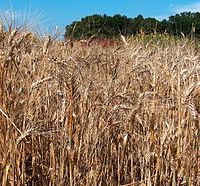
Reproductive and genetic roles of the maternal progenitor in the origin of common wheat (Triticum aestivum L.)
Sign Up to like & getrecommendations! Published in 2020 at "Ecology and Evolution"
DOI: 10.1002/ece3.6985
Abstract: Abstract Common wheat (Triticum aestivum L., AABBDD genome) is thought to have emerged through natural hybridization between Triticum turgidum L. (AABB genome) and Aegilops tauschii Coss. (DD genome). Hybridization barriers and doubling of the trihaploid… read more here.
Keywords: maternal progenitor; common wheat; wheat; wheat triticum ... See more keywords

The changes in the reproductive barrier between hexaploid wheat (Triticum aestivum L.) and rye (Secale cereale L.): different states lead to different fates
Sign Up to like & getrecommendations! Published in 2017 at "Planta"
DOI: 10.1007/s00425-017-2694-8
Abstract: AbstractMain conclusionThe changes in the reproductive barrier between hexaploid wheat (Triticum aestivumL.) and rye (Secale cerealeL.) can be induced using in situ embryo rescue of abnormal embryos, yielding stable fertile amphidiploid plants. In intergeneric crosses… read more here.
Keywords: reproductive barrier; wheat triticum; wheat; rye secale ... See more keywords

Microbispora tritici sp. nov., a novel actinomycete isolated from a root of wheat (Triticum aestivum L.)
Sign Up to like & getrecommendations! Published in 2019 at "Antonie van Leeuwenhoek"
DOI: 10.1007/s10482-019-01246-y
Abstract: A novel actinomycete, designated strain NEAU-HRGS1-13T, was isolated from a root of wheat (Triticum aestivum L.) and characterised using a polyphasic approach. Morphological and chemotaxonomic characteristics were consistent with those of members of the genus… read more here.
Keywords: novel actinomycete; isolated root; wheat triticum; hrgs1 13t ... See more keywords

Genome-wide association study for adult plant resistance to yellow rust in spring bread wheat (Triticum aestivum L.)
Sign Up to like & getrecommendations! Published in 2021 at "Euphytica"
DOI: 10.1007/s10681-021-02803-1
Abstract: Yellow rust, caused by Puccinia striiformis f. sp. tritici, is a common and serious fungal disease of wheat (Triticum aestivum L.) all over the world and particularly in the Central and West Asia and North… read more here.
Keywords: wheat triticum; plant; yellow rust; resistance ... See more keywords

The accumulation of cadmium in wheat (Triticum aestivum) as influenced by zinc oxide nanoparticles and soil moisture conditions
Sign Up to like & getrecommendations! Published in 2019 at "Environmental Science and Pollution Research"
DOI: 10.1007/s11356-019-05333-5
Abstract: Both cadmium (Cd) contamination in agricultural soils and drought stress pose a serious problem for crop quality and human health. Owing to the specific physical and chemical characteristics, zinc oxide (ZnO) nanoparticles (NPs) can be… read more here.
Keywords: wheat; wheat triticum; triticum aestivum; zinc oxide ... See more keywords

Phytoavailability, translocation and soil thresholds derivation of cadmium for food safety through soil-wheat (Triticum aestivum L.) system
Sign Up to like & getrecommendations! Published in 2021 at "Environmental Science and Pollution Research"
DOI: 10.1007/s11356-021-13385-9
Abstract: Cadmium (Cd) pollution in cultivated soils has posed a great risk to human health through the soil-plant-human pathway. Therefore, it is important to derive soil thresholds for the low-Cd accumulating genotype of wheat (Triticum aestivum… read more here.
Keywords: wheat; soil thresholds; wheat triticum; safety ... See more keywords

QTL analysis of falling number and seed longevity in wheat (Triticum aestivum L.)
Sign Up to like & getrecommendations! Published in 2017 at "Journal of Applied Genetics"
DOI: 10.1007/s13353-017-0422-5
Abstract: Pre-harvest sprouting (PHS) and seed longevity (SL) are complex biological processes of major importance for agricultural production. In the present study, a recombinant inbred line (RIL) population derived from a cross between the German winter… read more here.
Keywords: seed; qtl; wheat triticum; triticum aestivum ... See more keywords

Impact of imidacloprid treated seed and foliar insecticide on Hessian fly abundances in wheat (Triticum aestivum L.)
Sign Up to like & getrecommendations! Published in 2017 at "Crop Protection"
DOI: 10.1016/j.cropro.2017.03.007
Abstract: Wheat, Triticum aestivum L., is a major crop of economic importance throughout the United States. The Hessian fly, Mayetiola destructor (Say), is a common economically important pest, feeding on wheat in the larval stage through… read more here.
Keywords: wheat triticum; seed; foliar insecticide; hessian fly ... See more keywords

Effects of salicylic acid and organic selenium on wheat (Triticum aestivum L.) exposed to fenoxaprop-p-ethyl
Sign Up to like & getrecommendations! Published in 2018 at "Ecotoxicology and Environmental Safety"
DOI: 10.1016/j.ecoenv.2017.11.053
Abstract: Abstract In this study, we evaluated effects of fenoxaprop-p-ethyl herbicide on wheat (Triticum aestivum L.). The wheat plants were grown in pots containing perlite. Fenoxaprop-p-ethyl was applied to adequately grown T. aestivum plants at determined… read more here.
Keywords: salicylic acid; wheat; wheat triticum; fenoxaprop ethyl ... See more keywords

Photosynthetic acclimation strategies in response to intermittent exposure to high light intensity in wheat (Triticum aestivum L.)
Sign Up to like & getrecommendations! Published in 2021 at "Environmental and Experimental Botany"
DOI: 10.1016/j.envexpbot.2020.104275
Abstract: Abstract Plants are intermittently exposed to high intensity light; however, it is unknown how the photosynthetic apparatus of cultivated crops, such as wheat (Triticum aestivum L.), acclimatizes to intermittent high light conditions. To address this… read more here.
Keywords: light; exposure; triticum aestivum; wheat triticum ... See more keywords

Wheat (Triticum aestivum L.) flour free lipid fractions negatively impact the quality of sponge cake.
Sign Up to like & getrecommendations! Published in 2019 at "Food chemistry"
DOI: 10.1016/j.foodchem.2018.07.181
Abstract: The functionality of wheat flour lipids in sponge cakes prepared from flour, sugar, eggs and leavening agents only was investigated by altering their location or content in flour. Hexane (hex) or the more polar hexane:isopropanol… read more here.
Keywords: negatively impact; sponge; wheat triticum; sponge cake ... See more keywords